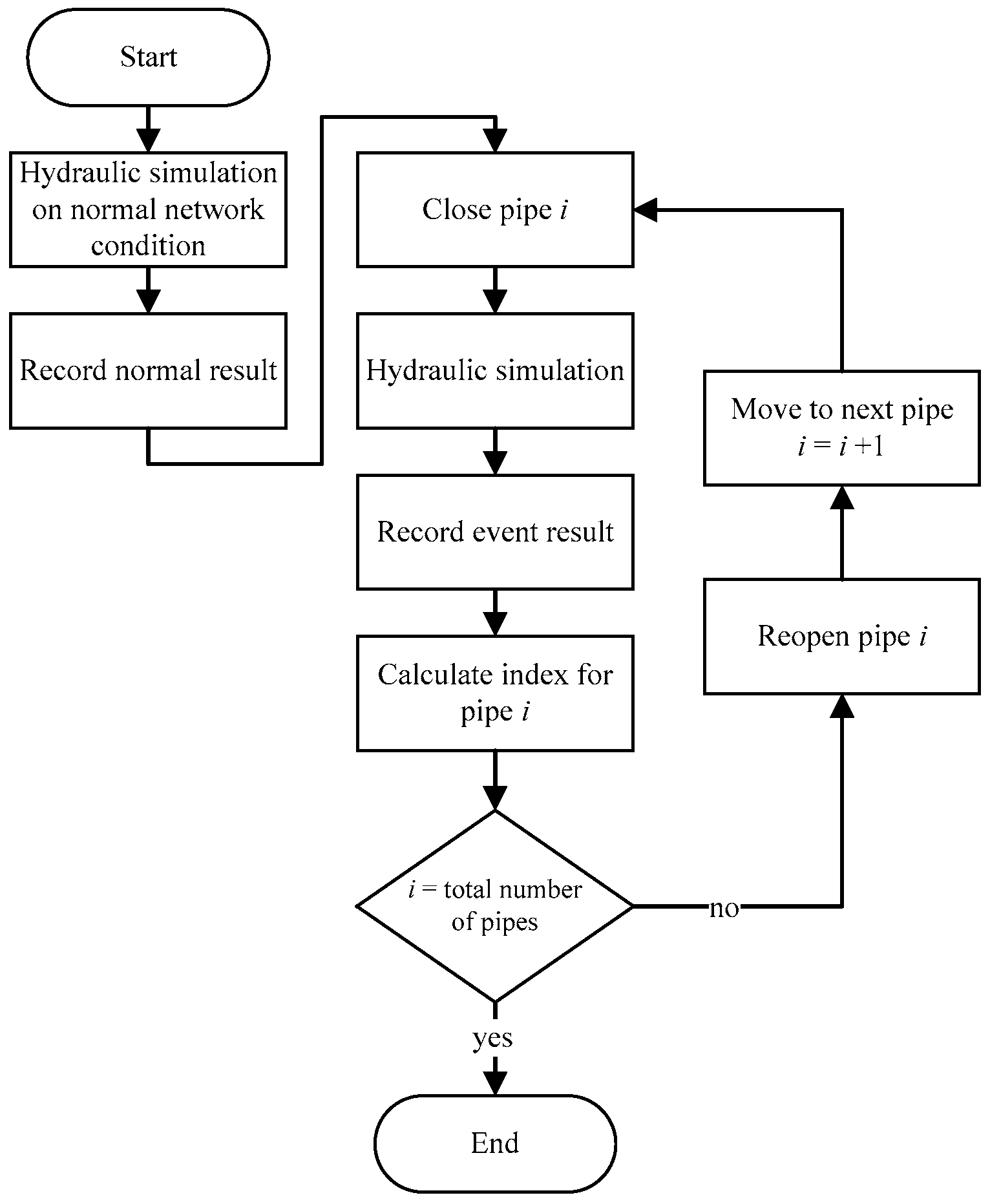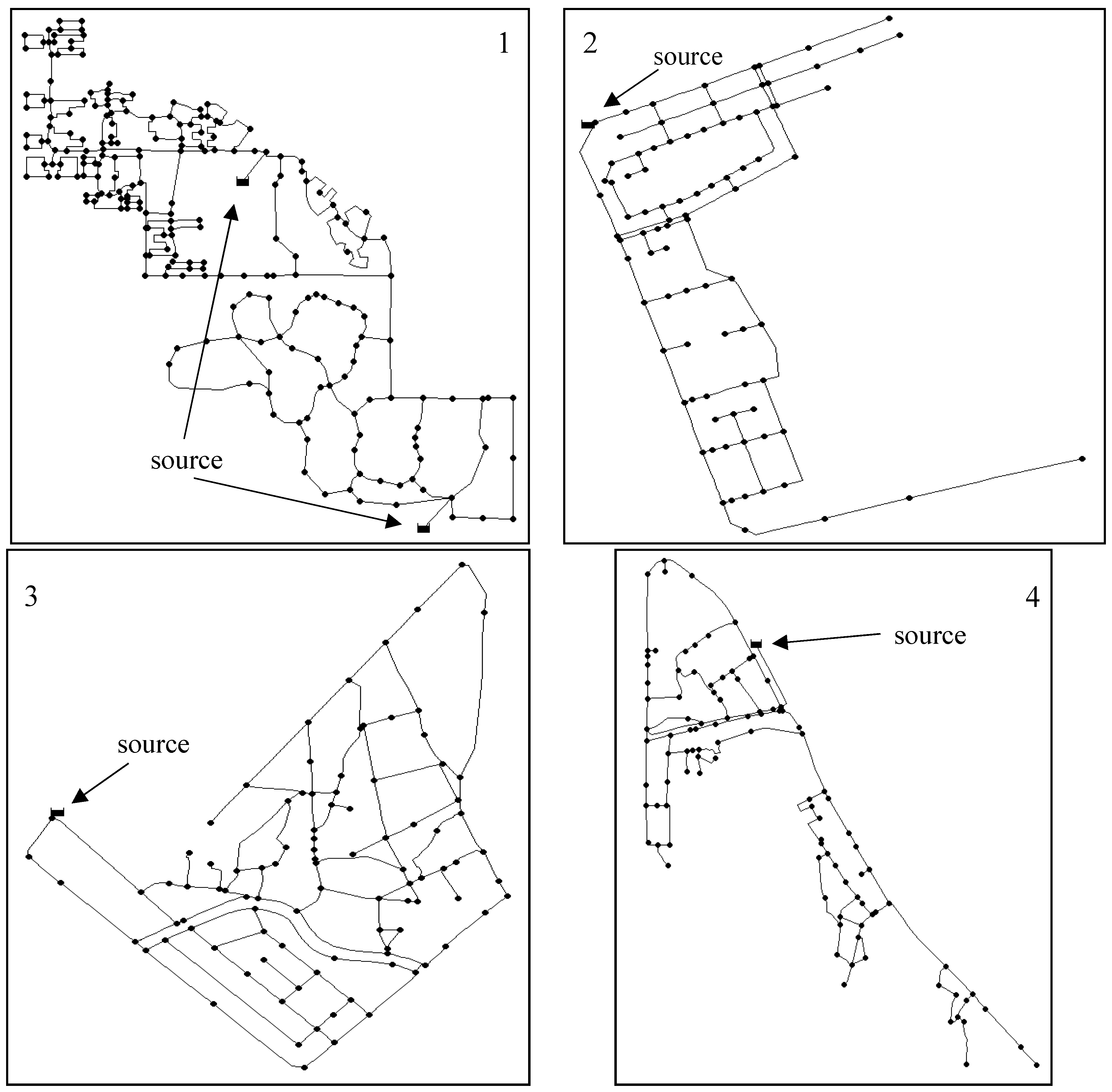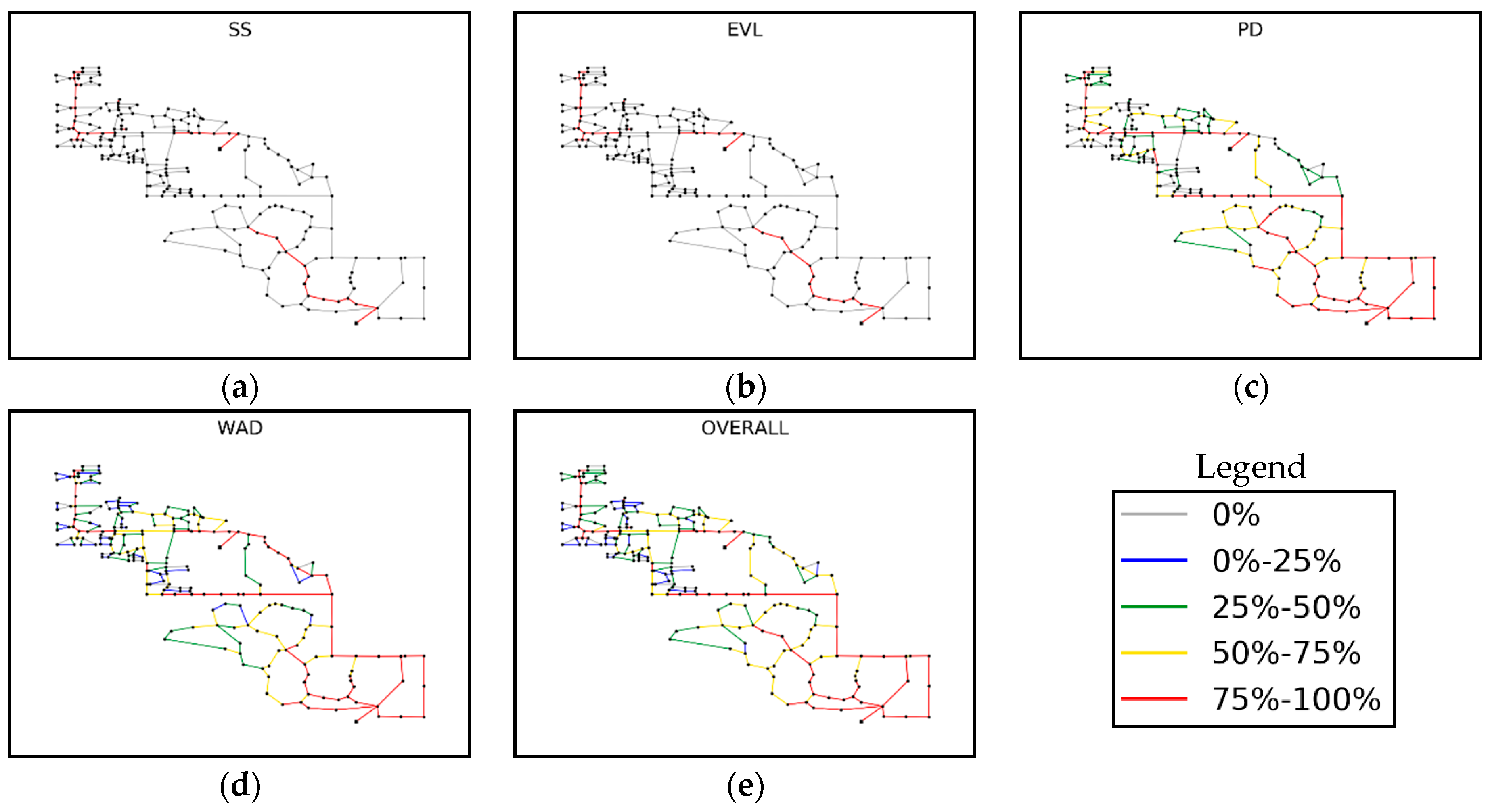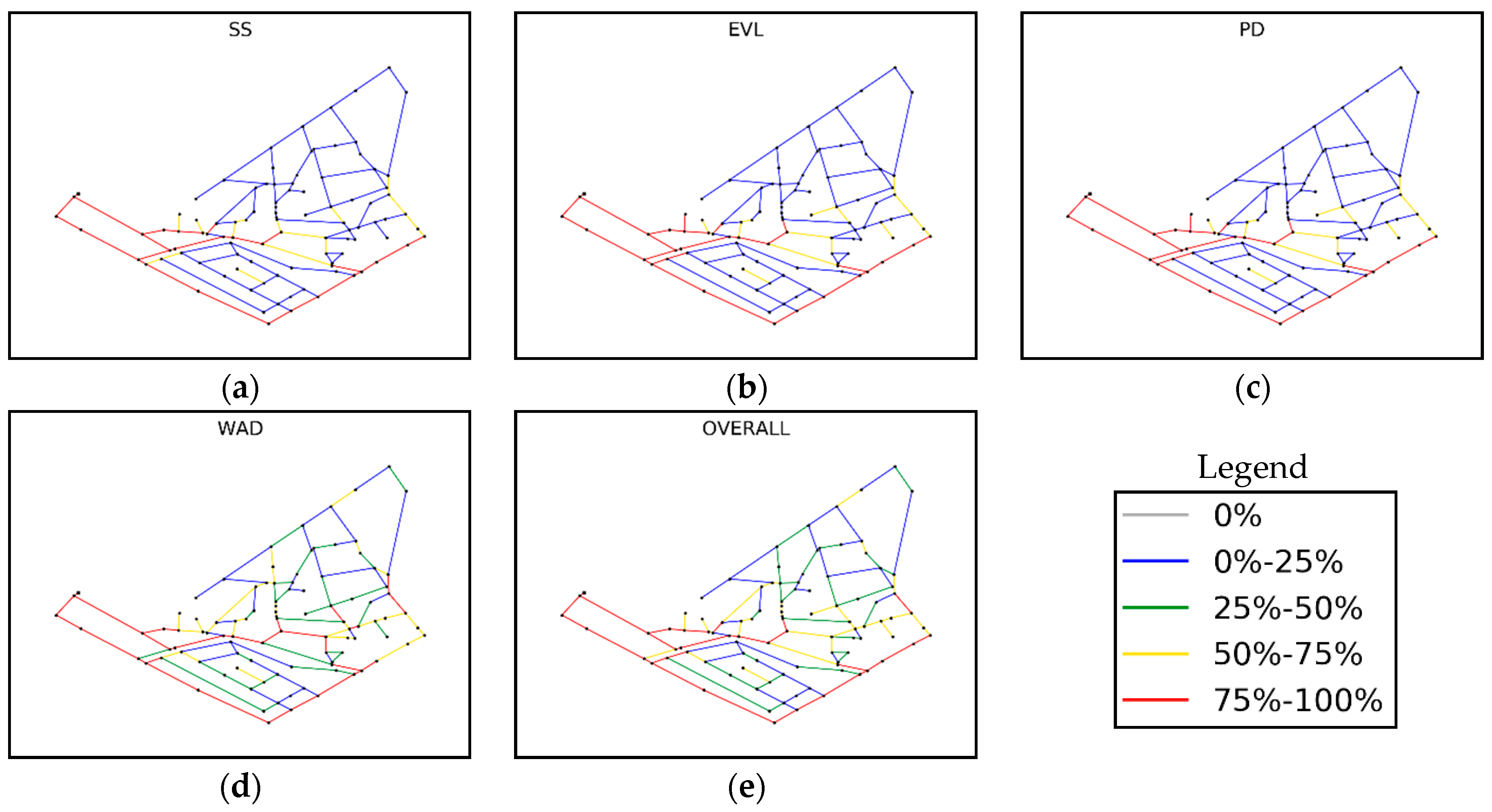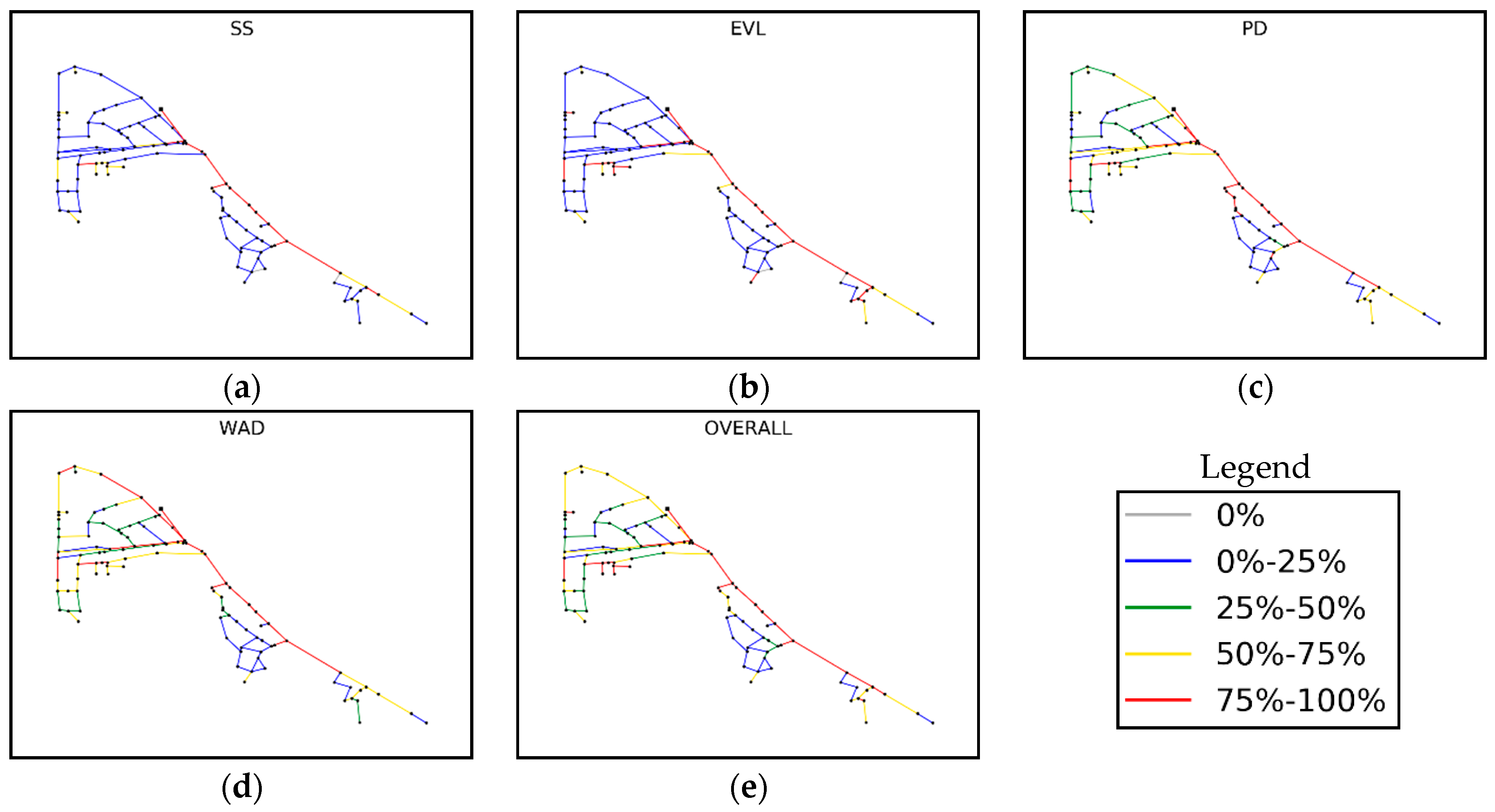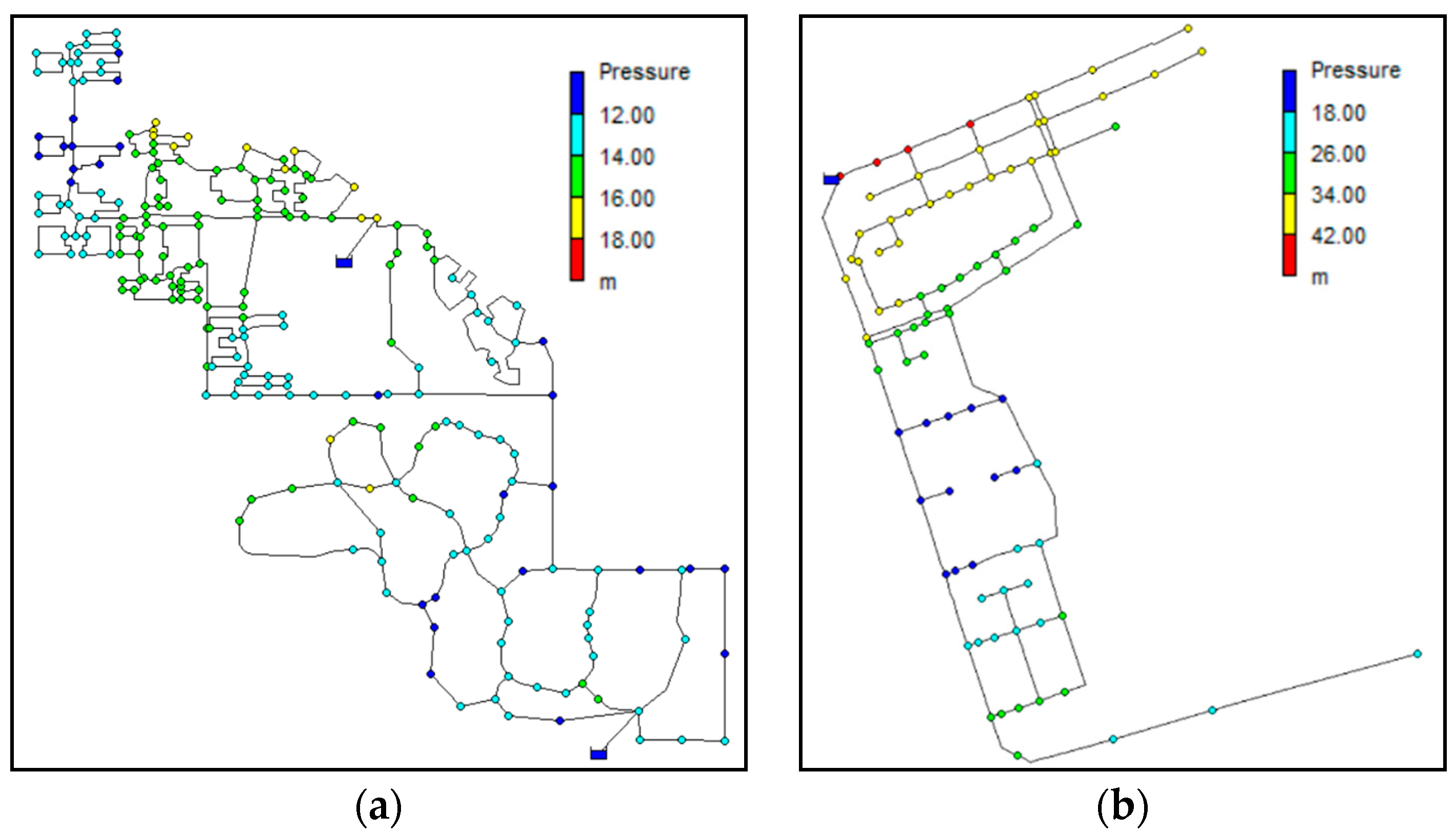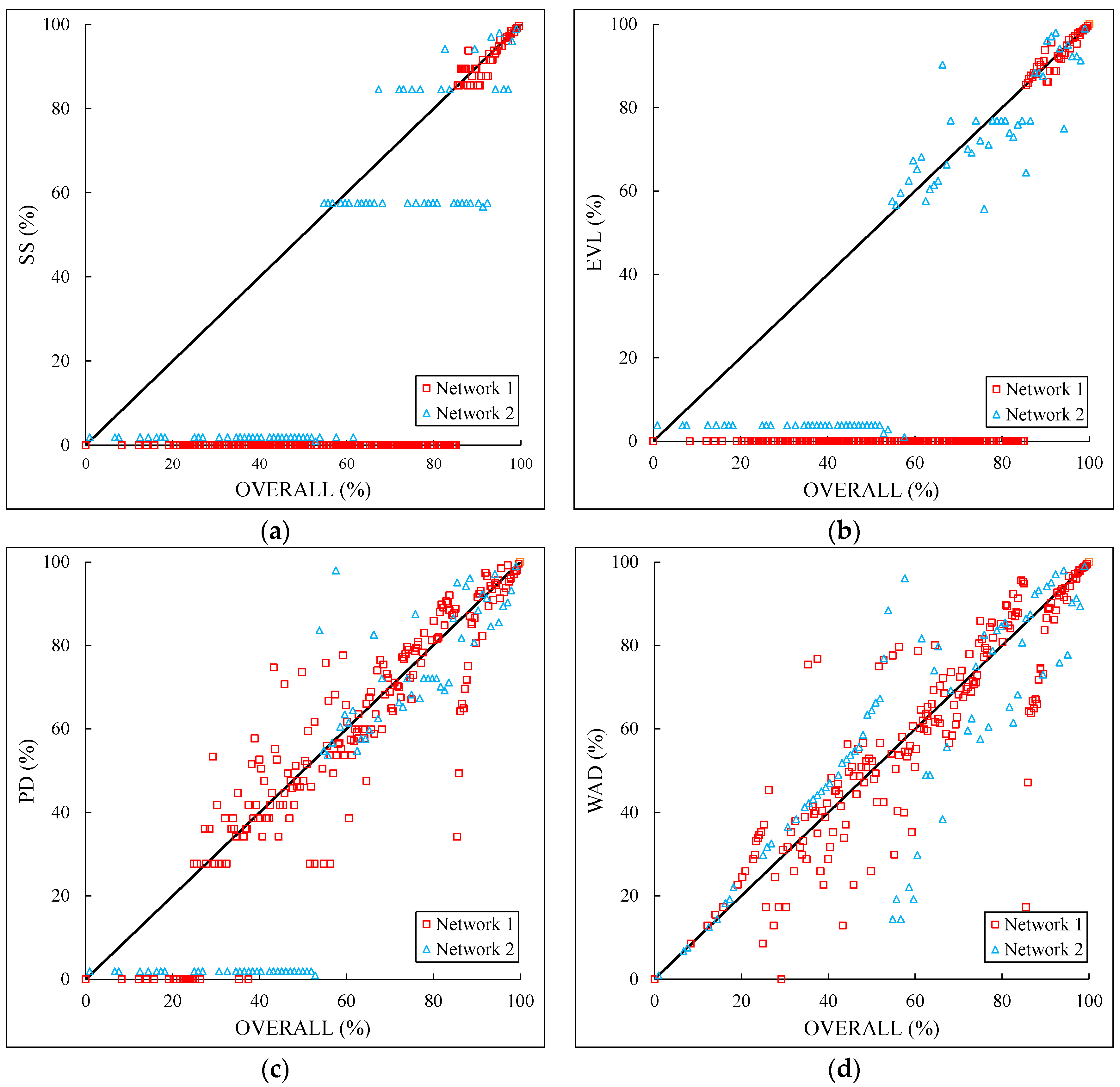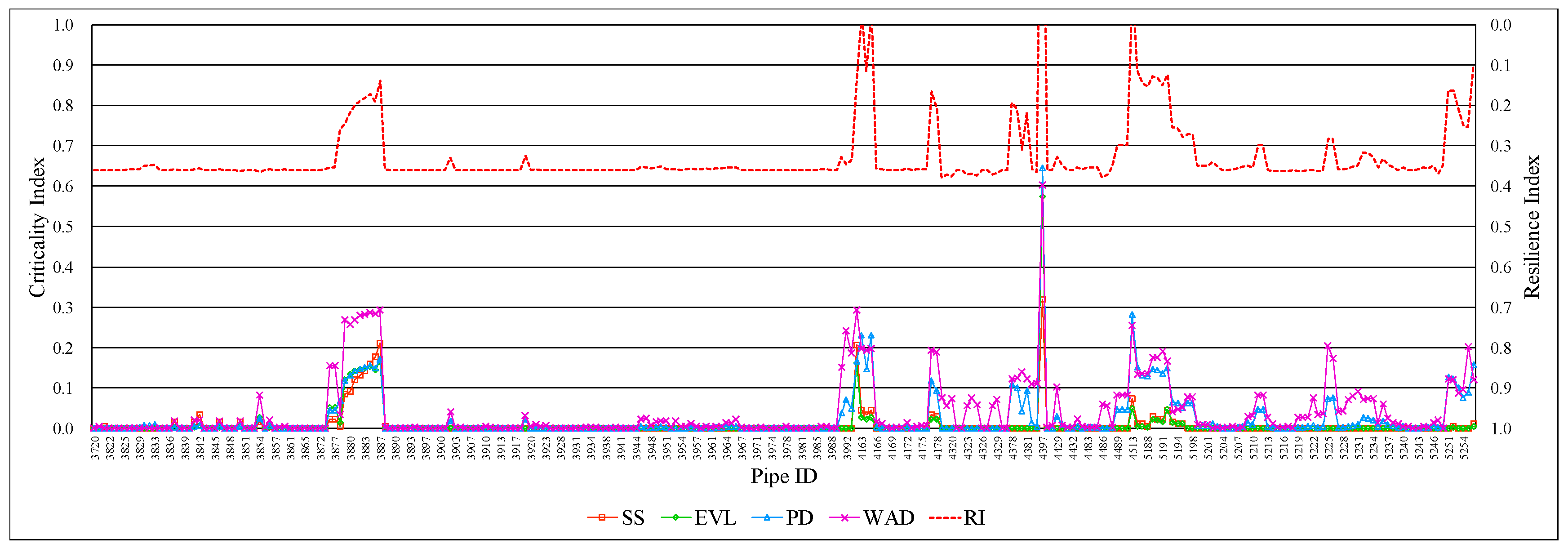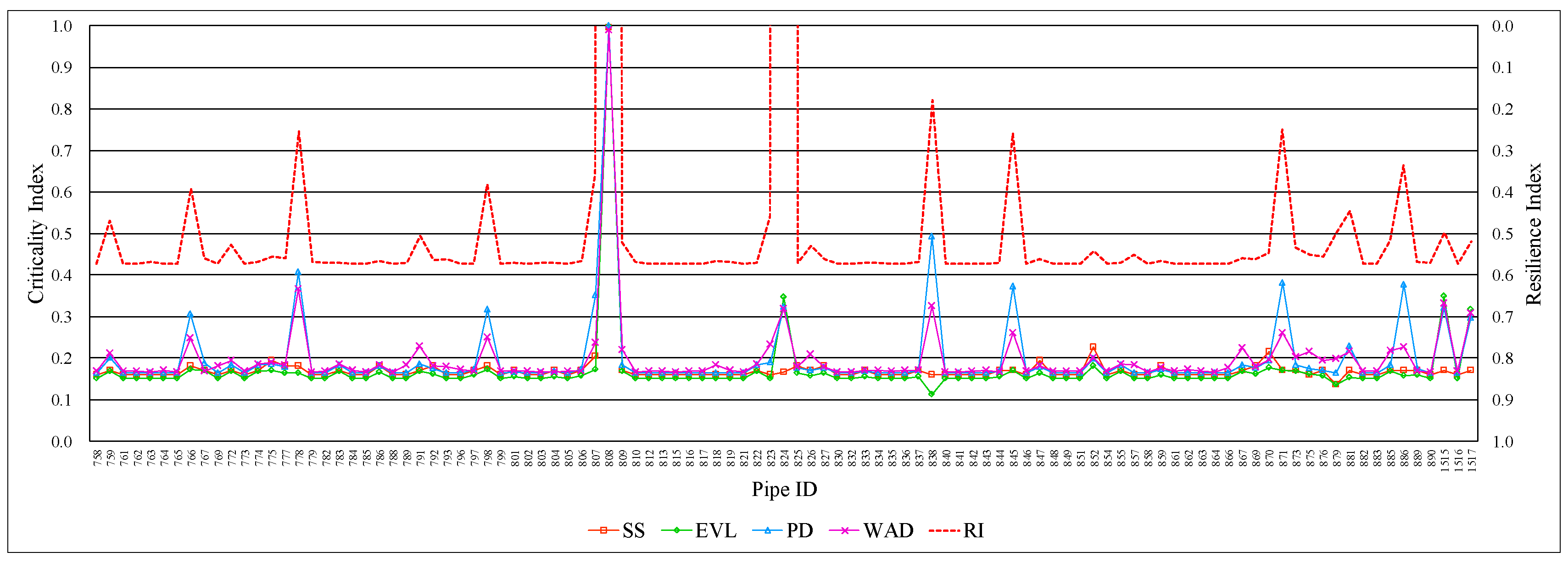1. Introduction
A water distribution network (WDN) is an essential infrastructure supplying water to maintain daily and economic activities of the users connected to it. The WDN itself is composed of many elements that are interconnected and state a certain degree of functionality for the network. A disruption event upon the network will result in a loss of network functionality, which will consequently affect the customers to a certain degree.
Among the many elements in a WDN, pipes are the primary components connecting each other. Each of these pipes can be afflicted by failure (i.e., breakage), which renders the pipe unusable. In the event of a pipe failure, it has to be isolated from the network, and the network functionality will decrease depending on the importance of the removed pipe. By calculating the functionality decrement of individual pipes, the criticality of each pipe can be estimated. The criticality of the pipe is valuable information that can be used to determine the proper maintenance priority accordingly [
1]. Since a WDN is an infrastructure with hydraulic capability that serves many users, a failure event will impact both the inner workings and the receiving side.
Wagner et al. [
2] introduced the primary concepts of WDN design reliability into mechanical and hydraulic reliability. According to Mays [
3], the mechanical reliability focuses on the network topology, evaluating system connectivity given the failure conditions, and the hydraulic reliability refers to the ability of a system to meet the requirements of water flow and pressure.
In the context of mechanical reliability, Su et al. [
4] suggested a mechanical reliability indicator using a concept of pipe availability based on pipe failure statistics. Later, Fujiwara and Tung [
5] advanced this pipe availability indicator by estimating the failure probability according to a pipe size variation. Khomsi et al. [
6] also advanced the pipe availability by considering the water availability under a simulation of pipe failure and repair events. On the other hand, in the context of hydraulic reliability, Xu and Goulter [
7] estimated system reliability based on the nodal pressure simulated, and later Shi and O’Rourke [
8] suggested a reliability index using actual demand and pressure at demand nodes.
The available pressure and supplied flows can be considered simultaneously as an energy term. The resilience index (RI) is a well-known measurement of WDN reliability based on nodal flow and excessive pressure [
9]. The RI has been used to evaluate system performance and contributed to the development of various post-indexes. For example, Prasad and Park [
10] developed the network resilience index (NRI) by considering network connectivity. The NRI is known as a representative hydraulic-topological combined reliability index. Jayaram and Srinivasan [
11] developed the modified resilience index (MRI), which calculates redundancy of WDN using surplus energy and minimum required energy. Recently, the resilience indexes were revisited by Jeong et al. [
12] by suggesting a new definition of surplus and the minimum required head at a node considering the flow direction in pipes and the hydraulic gradient of the network.
Besides the resilience-type indexes, there are many other indicators developed using the energy-based concepts. Cabrera et al. [
13] proposed five energy-efficiency indicators to evaluate the WDN capacity, and later Cabrera et al. [
14] suggested a new method for assessing the energy states in WDNs. Similarly, Dziedzic and Karney [
15] analyzed water distribution sustainability using different energy classifications in water networks, such as supplied, delivered, lost, and dissipated energy. Moreover, Hashemi et al. [
16] proposed five energy metrics based on six energy categories, including supplied, delivered, required, downstream flow, leakage, and friction energy in WDNs.
Recently, several water quality indicators were developed. Alsaqqar et al. [
17] summarized various water quality measurements and introduced quantification indexes for water quality assessment, such as the Langelier saturation index (LSI) and Ryznar stability index (RSI). Moreover, Mortula et al. [
18] demonstrated various water quality indicators by spatial, temporal, and hotspot analysis using Moran’s index (correlation) and Getis-Ord Gi (spatial clustering).
Summarizing the previous research, the majority of indexes focused on the hydraulic outcomes of WDNs and few studies introduced water quality aspect. None of them seek multiple aspects of WDNs services (e.g., social, water quality, and economic, etc.), rather focus on a single item. In addition, the aforementioned metrics are based on a system-based analysis to measure the functional capability of the entire network. By applying these metrics, however, no information on the location of the vulnerable part can be obtained. To overcome the drawbacks of the conventional metrics, we propose an element-based analysis in which individual components are evaluated using several performance quantification metrics to identify the critical elements in WDNs. By locating and prioritizing the critical elements of the network, actions can then be accordingly planned to improve the network resiliency against potential disturbances.
The objective of this study is to identify critical pipes in a WDN. To that end, first, several criticality indexes are developed to measure the network performance loss during a disturbance event. The indexes are then applied to several networks to analyze the responses. The responses from the separate indexes are then combined to determine the overall criticality of individual pipes. Finally, a verification of the proposed criticality indexes is conducted by comparing them with the resilience index (RI).
2. Criticality Indexes
To identify the critical elements in WDNs, indexes are useful to quantify the criticality of individual pipes. The proposed indexes are intended to measure the loss of network functionality in four different aspects: social, economic, hydraulic, and water quality. All the developed indexes range from 0 to 1, where a value closer to 0 states a lesser criticality and a value closer to 1 states a greater criticality of the pipe in the network.
2.1. Social Index
If demand at a node is not fully supplied, there will be a certain level of dissatisfaction of the users connected to the node. The level of dissatisfaction is related to the ratio of supply and demand. That is, higher dissatisfaction will occur with the lower demand supplied. Here, a supply shortage (
SS) index is proposed by calculating the ratio of supply and demand at each node during the isolation of a certain pipe. Equation (1) expresses the
SS index proposed.
Here, is the supply shortage index with the isolation of pipe i; N is the total number of nodes in the WDN; is the supplied demand at node j after an event (i.e., isolation of a pipe); and is the normal demand at node j.
2.2. Economic Index
The reduced water supply will incur an economic loss on the user side. Water has different economic value depending on the user. For municipal users, the supply shortage will disrupt daily activities and commerce. Meanwhile, for an industrial area, the water shortage will decrease the product amount or halt the manufacturing process, resulting in higher economic loss compared to the municipal area. Here, an economic value loss (
EVL) index is developed to quantify the economic loss due to a disruption event of a WDN. Equation (2) represents the equation of the
EVL index.
Here, is the economic value loss index with the isolation of pipe i; is the time to repair the pipe i; and is a unit value of water at node j.
In this study, the unit values of water are 0.1577
$/m
3 for the municipal sector and 0.2293
$/m
3 for the industrial sector [
19].
is the average time spent to repair a pipe depending on the pipe diameter and is calculated using a regression curve proposed by Walski and Pelliccia [
20]. Equation (3) expresses the equation of
in hours.
Here, is the diameter of pipe i in inches.
2.3. Hydraulic Index
During a failure event, the network pressure is likely to decrease, since isolating a pipe may block the regular flow path and detouring other longer paths will increase the flowrate and overall head losses. The reduction of pressure at the nodes is measured using a pressure decline (
PD) index, which compares the normal pressure and declined pressure during a failure event while considering the nodal demand as a weighting factor; this is so that a node with a higher demand has more influence on the index. Equation (4) represents the calculation of the
PD index.
Here, is the pressure decline index with the isolation of pipe i; is the pressure at node j after the event; and is the normal pressure at node j.
2.4. Water Quality Index
Various water quality issues exist in WDNs, such as disinfection by-product formation, microbial regrowth, sediment deposition, and odor/taste of chlorine [
21]. However, these issues are difficult to simulate and it is hard to develop a quantification index for them. Meanwhile, water age is relatively simple to simulate, thus can be used as an indicator for measuring water quality in WDNs. Water age of a node is defined as the time for water to travel from a source to the particular node. Here, the water age is calculated using a chemical option in EPANET. A chemical with zero decay is put at the source and elapsed time is recorded for individual nodes when a node firstly detects the arrival of the chemical. Here, the water age growth due to pipe isolation is measured using a water age degradation (
WAD) index. The nodal demand is considered as a weighting factor so that a node with higher demand has a greater impact on the index. Equation (5) expresses the calculation of the
WAD index.
Here, is the water age degradation index with the isolation of pipe i; is the water age at node j after the event; and is the normal water age at node j.
5. Discussion and Conclusions
To identify and prioritize the critical pipes in a WDN, an element-based simulation approach is proposed. The element-based criticality is measured using four criticality indexes, including supply shortage (SS), economic value loss (EVL), pressure decline (PD), and water age degradation (WAD). These indexes measure different aspects of performance degradation, specifically social, economic, hydraulic, and water quality, respectively. Evenly weighting the four indexes, the OVERALL criticality is calculated to identify and prioritize the critical pipes.
For demonstration, the proposed indexes are applied to four networks that have different characteristics. The results show that each index representing different aspects yields variable criticality ranks per pipes. The individual results are then combined into a single criticality value to provide the overall assessment of criticality of individual pipes. The network type also affects the criticality results; here, we have compared four different networks from the densely loop to the branch-loop hybrid type. Generally, it was found that the pipes with large sizes and serving high-demand nodes tend to show greater criticality. However, the topological parameter (DoN) shows a certain relation with the pipe criticality depending on the network type. For verification of the proposed indexes, a comparison test with the well-known RI was conducted. Both results indicate similar patterns and commonly identify the critical pipes. It is noteworthy that the proposed indexes quantify four distinct aspects of WDNs service, while the RI only deals with the hydraulic performance. Thus, the proposed indexes are likely to improve the criticality assessment of a pipe network.
The proposed element-based simulation approach can be used to identify the critical pipes in a network, and using this information, the area with a high maintenance priority can be determined to maintain network function. Overall, the proposed element-based index can be utilized to setup maintenance scheduling for preparedness of potential failure events. The proposed approach can be further improved for assessment of other components in WDNs, and various operation aspects can also be added in future development.
